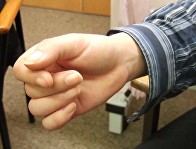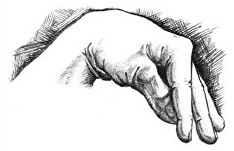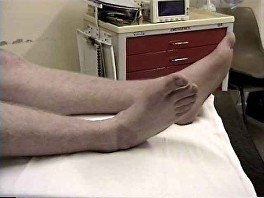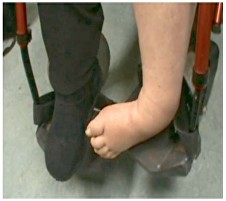Pasienter med funksjonell dystoni har ofte enten «bøyde fingre» eller «knyttet hånd».
Det andre vanlige symptomet ved funksjonell dystoni er at ankelen peker inn og ofte nedover.
Disse endrede stillingene kan være vanskelige og noen ganger umulige for pasienten å endre og det kalles da «fiksert dystoni».
Dette kan være et forbigående og “til og fra”-problem (spasme) eller kronisk (dette er som regel kalt fiksert/funksjonell dystoni).




Alle har «et kart» av kroppen inkludert av armer og ben i hjernen. Det kan se ut som dette kartet i hjernen er annerledes/blitt endret ved funksjonell dystoni. Hjernen tror at en “bøyd hånd» og en «vridd ankel» er normalt, selvom du egentlig vet at det ikke er slik.
Det kan se ut som både fysiske skader, svakhet i en arm eller ben og immobilisering kan bidra til å ødelegge/endre dette «kartet» i hjernen.
Utfordringen med behandlingen er å gjenskape hjernen slik at den kan lære hva «et normal kart» av ekstremiteten bør være.
Det er overlapp med tilstander som er kalt komplekst regionalt smertesyndrom (CRPS). Du kan lese mer om dette på en egen side.
Ved kompleks regional smertesyndrom så får pasienten smerter i en ekstremitet som ikke blir borte, men tvert i mot blir verre etter at skaden har leget.
Funksjonell dystoni er en av komplikasjonene ved komplekst regionalt smertesydrom.
Smerte er vanlig ved funksjonell dystoni, men man kan også være uten smerte ved funksjonell dystoni.
Diagnosen funksjnoell dystoni bør stilles av en lege som er kjent med de ulike årsakene til dystoni.
Funksjonell dystoni begynner ofte ganske plutselig, men kan begynne gradvis også. Det kan komme etter en av følgende situasjoner:
1. Et fysisk traume mot ekstremiteten eller smerte i ekstremiteten. Som beskrevet over kan funksjonell dystoni være en del av komplekst regionalt smertesyndrom.
2. Etter en periode med immobilisering, spesielt sammen med funksjonell ekstremitetslammelse
3. En underliggende mild tilleggsårsak som har blitt «forsterket» med en funksjonell dystoni. En funksjonell dystoni må mistenkes når en voksen pasient har fått en nyoppstått dystoni som likner på mønsteret over, og som er assosiert med andre funksjonelle nevrologiske symptomer og som kommer ganske plutselig.
Dystoni er en nevrologisk beskrivelse av unormale og persisterende muskelkontraksjoner med endring av stilling.
Det er mange former for dystoni som inkluderer skrivekrampe, nakkedystoni (inkludert torticollis) og generalisert dystoni. Dystoni kan også oppstå ved en rekke ulike nevrologiske tilstander.
Noen typer dystoni, slik som “skrivekrampe” er ikke alltid assosiert med hjernesykdom, så hvorfor er ikke de også klassifisert som funksjonelle sykdommer?
Kanskje en av de viktigste tingene å understreke er at funksjonelle sykdommer er genuine og involverer at hjernen gjør noe galt.
Men funksjonelle sykdommer er også karakterisert av at de er potensielt reversible og funksjonell dystoni, som kan se fiksert ut, kan bedre seg under hyponose, eller fysioterapi, mens andre former for dystoni sjeldent responderer slik på denne typen terapi.
I tillegg har vanligvis ikke pasienter med skrivekrampe de andre funksjonelle symptomene og lidelsene beskrevet på disse sidene, mens pasienter med funksjonell dystoni typisk har dette.
Det er ikke å fornekte at funksjonell dystoni er et godt eksempel på hvor vanskelig og kanskje til og med feil det er å dele opp problemer i “sykdommer” eller ikke.
Se sidene om behandling.
Er du sikker på diagnosen?
Det er viktig at du føler deg trygg på at det er korrekt diagnose. Hvis du ikke er det, vil det bli vanskelig å ta i bruk rehabiliteringsteknikkene som er foreslått her.
Hvis du ikke føler at du har en funksjonell dystoni, så må du se på hva som er grunnlaget for diagnosen. Du bør ha noen av de kliniske kjennetegnene nevnt over. Hvis du har det, hvorfor er du ikke sikker på diagnosen som er gitt?
Du trenger ikke være stresset over å ha en funksjonell dystonidiagnose. Faktisk er funksjonell dystoni mest merkbar når personen er avslappet eller ikke tenker på noe spesielt. Kanskje du avviste diagnosen fordi legen foreslo at den var «stressrelatert»?
Det kan ha vært misforståelser hvis det var tilfelle. Vi vet at mange pasienter med funksjonell dystoni har stress som en årsak til symptomene, men mange har det ikke. Så om du har vært stresset eller ikke er egentlig irrelevant for diagnosen.
Spesifikke fysioterapiteknikker
Vi lærer fortsatt hvilke teknikker og tiltak som er til mest hjelp for funksjonell dystoni
Som et generelt prinsipp, det å bevege den syke kroppsdelen er veldig viktig, selv om den er fiksert og det ikke er mulig.
Noe av dette kan være til hjelp.


Vi vil omdirigere deg til University of Edinburghs donasjonsside, som muliggjør donasjoner på en sikker måte på våre vegne. Vi bruker donasjoner for å holde nettstedet i gang og til videre FNL-forskning.
